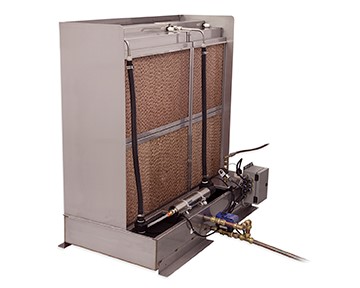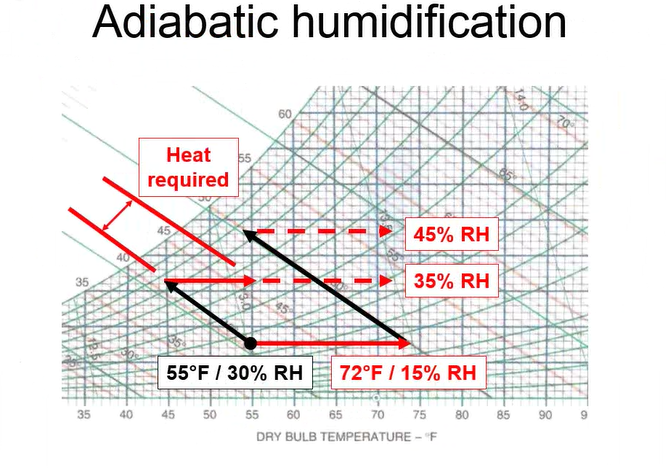Recently, we discussed isothermal humidification. Today, we’re going to talk about the other method of humidification, which is called “Adiabatic.” Adiabatic humidification puts water (not steam) directly into the air using a spray mechanism or wetted medium, and the heat from the surrounding air causes the water to evaporate. So instead of sliding up the vertical dry bulb temperature line on the psychrometric chart, we move diagonally along the wet bulb line.
How to Use Adiabatic Humidification
The chart below shows a few different humidification scenarios, but no worries: we’ll break it down for you. Let’s start with the black dot, which is our outdoor supply air condition of 55°F at 30% RH.
Using an adiabatic humidifier, we put moisture into the air, increasing the humidity from approximately 30% to about 85%. Note that the black dot moves up and to the left in parallel with the wet bulb lines on the chart. At the same time, natural evaporation drops the air temperature to about 45°F. This is too cold to put directly into the space, so we have to add heat to get the temperature back up to 55°F, which causes the RH to drop from 85% to approximately 50%. If we put this air into our 72°F space, we end up with an RH of approximately 30%.
But let’s say we want to take the space up to 45% RH. To do that, we would have to add more moisture and more heat, basically zig-zagging up the psychrometric chart. At this point, you would actually need both preheat and reheat to offset the cooling effect of the evaporation before the air is put into the space.
You may wonder, given these particular conditions, why you don’t want to add the 55°F at 30% RH directly into the space. Again, you can’t change one value without changing another. If we were to put the 55°F/30% RH air directly into a 72°F space (thus changing the dry bulb), we’d simultaneously lower the RH to 15% as we move horizontally to right on the psychrometric chart. That is far too dry for human comfort.
So adiabatic humidification can involve some degree of reheat, although it can be an effective method when working with warm, dry supply air temperatures and the absorption distance is not critical.
When to Use Adiabatic Humidification
So when is adiabatic a good solution for humidification? The best applications are when you have a warm and dry supply air. Then you can take advantage of the sensible heat in the supply air and, in the right situations, take advantage of the free cooling that they can provide. They can also be used with RO or DI water to reduce maintenance and provide pure, particulate-free humidity.
Some typical Adiabatic technologies include:
• Pressurized water humidifiers
• Wetted media humidifiers
• Ultrasonic humidifiers
• Pressured air and water humidifiers
• Centrifugal humidifiers
Pressurized water humidifiers used with DI or RO water can provide a high level of capacity and control while having a low maintenance requirement. They also have the highest ability to stay online if they’re used in a critical process where space conditions always have to be maintained.
In both adiabatic and isothermal processes, approximately 1000 BTUs per pound of water are required to change the water from a liquid to a vapor. However, in isothermal humidification, that energy is taken from boiling water. In adiabatic, that energy comes from the surrounding air.



